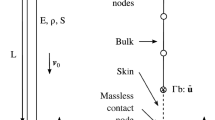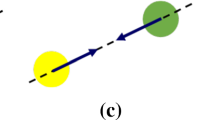Abstract
Finite element models are often used to simulate impact and contact dynamics responses of multibody dynamical systems. However, such a simulation remains very inefficient because very small integration time step must be used when solving the involved differential equations, especially when the involved contact stiffness is high. Although many model reduction techniques have been available to improve the efficiency of finite element based simulations, these techniques cannot be readily applied to contact dynamics simulations due to the high nonlinearity of the contact dynamics models. This paper presents a model reduction approach for finite-element based multibody contact dynamics simulation, based on a modified Lyapunov balanced truncation method. An example is presented to demonstrate that, by applying the model reduction the simulation process is significantly speeded up and the resulting error is bounded within an acceptable level. The performance of the method with respect to some influential factors such as element size, shape and contact stiffness is also investigated.
Similar content being viewed by others
References
Ma O, Buhariwala K, Neil R, Maclean J, Carr R. MDSF-A generic development and simulation facility for flexible, complex robotic systems. Robotica, 1997, 15(1): 49–62
Gilardi G, Sharf I. Literature survey of contact dynamics modeling. Mechanism and Machine Theory, 2002, 37(10): 1213–1239
Ebrahimi S, Hippmann G, Eberhard P. Extension of the polygonal contact model for flexible multibody systems. International Journal of Applied Mathematics and Mechanics, 2005, 1: 33–50
Hippmann G. An algorithm for compliant contact between complexly shaped surfaces in multibody dynamics. Multibody Dynamics, 2003, 1–19
Zhong Z H. Finite Element Procedures for Contact-impact Problems. New York: Oxford University Press Inc., 1993
Kane C, Repetto E A, Ortiz M, Marsden J E. Finite element analysis of non-smooth contact. Computer Methods in Applied Mechanics and Engineering, 1999, 180(1–2): 1–26
Jackson L R, Green I. A finite element study of elasto-plastic hemispherical contact against a rigid flat. Journal of Tribology, 2005, 127(2): 343–354
Moore B. Principal component analysis in linear systems: controllability, observability, and model reduction. IEEE Transactions on Automatic Control, 1981, 26(1): 17–32
Pernebo L, Silverman L. Model reduction via balanced state space representations. IEEE Transactions on Automatic Control, 1982, 27(2): 382–387
Rowley C W. Model reduction for fluids, using balanced proper orthogonal decomposition. International Journal of Bifurcation and Chaos in Applied Sciences and Engineering, 2005, 15(3): 997–1013
Barbagallo A, Sipp D, Schmid P J. Closed-loop control of an open cavity flow using reduced-order models. Journal of Fluid Mechanics, 2009, 641: 1–50
Heirman G H K, Naets F, Desmet W. Forward dynamical analysis of flexible multibody systems using system-level model reduction. Multibody System Dynamics, 2011, 25(1): 97–113
Antoulas A C, Sorensen D C, Gugercin S. A survey of model reduction methods for large-scale systems. Contemporary Mathematics, 2001, 280: 193–219
Gugercin S, Antoulas A C. A survey of model reduction by balanced truncation and some new results. International Journal of Control, 2004, 77(8): 748–766
Lumley J. The structure of inhomogeneous turbulent flow. Atmospheric Turbulence and Radio Wave Propagation, 1967, 167–178
Hotelling H. Analysis of a complex statistical variables with principal components. Journal of Education Psychology, 1933, 24(7): 417–441, 498–520
Mullis C T, Roberts S R. Synthesis of minimum round-off noise fixed point digital filters. IEEE Transactions on Circuits and Systems, 1976, 23(9): 551–562
Hunt K H, Crossley F R E. Coefficient of restitution interpreted as damping in vibroimpact. Journal of Applied Mechanics, 1975, 42(2): 440–445
Guyan R J. Reduction of stiffness and mass matrices. AIAA Journal, 1965, 3(2): 380
Craig R R, Bampton M C C. Coupling of substructures for dynamics analysis. AIAA Journal, 1968, 6(7): 1313–1319
Ma O, Wang J. Model order reduction for impact-contact dynamics simulations of flexible manipulators. Robotica, 2007, 25(4): 397–407
Salimbahrami B, Lohmann B. A simulation-free nonlinear model order-reduction approach and comparison study. Mathematical and Computer Modeling of Dynamical Systems, 2004, 10(3–4): 317–329
Willcox K, Peraire J. Balanced model reduction via the proper orthogonal decomposition. AIAA, 2002, 40(11): 2323–2330
Author information
Authors and Affiliations
Corresponding author
Rights and permissions
About this article
Cite this article
Liang, J., Ma, O. & Liu, C. Model reduction of contact dynamics simulation using a modified Lyapunov balancing method. Front. Mech. Eng. 6, 383–391 (2011). https://doi.org/10.1007/s11465-011-0244-9
Received:
Accepted:
Published:
Issue Date:
DOI: https://doi.org/10.1007/s11465-011-0244-9




